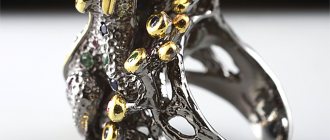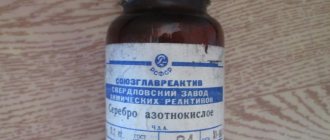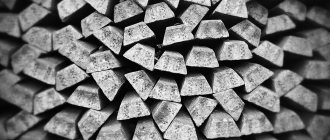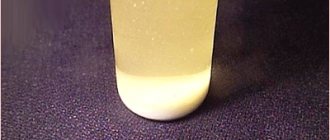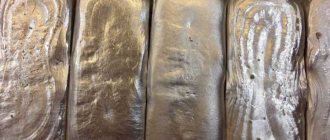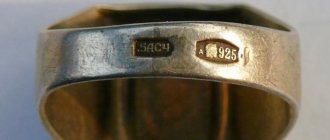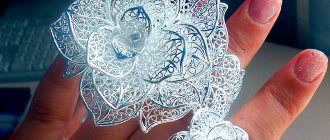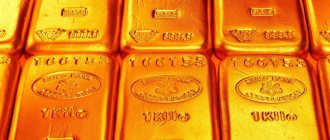Silver chloride I
(
silver chloride
) - AgCl, an inorganic binary compound of silver with chlorine, a silver salt of hydrochloric (hydrochloric) acid. Under normal conditions it is a white powder or colorless crystals. Occurs in nature as the mineral chlorargyrite.
| Silver chloride I | |
| Systematic name | Silver chloride I |
| Traditional names | Silver chloride |
| Chem. formula | AgCl |
| Rat. formula | AgCl |
| State | hard |
| Molar mass | 143.32 g/mol |
| Density | 5,56 |
| Hardness | 2,5 |
| Temperature | |
| • melting | 455 |
| • boiling | 1554 °C |
| Mol. heat capacity | 50.79 J/(mol K) |
| Enthalpy | |
| • education | −127 kJ/mol |
| Specific heat of evaporation | 1,28⋅106 |
| Specific heat of fusion | 9,2⋅104 |
| Steam pressure | 1 Pa, 10 Pa, 100 Pa, 1 kPa, 10 kPa and 100 kPa |
| Solubility | |
| • in water | 1.91⋅10−5 g/100 ml |
| • in ethanol | 1.5·10−5 g/l |
| • in methanol | 6·10−5 g/l |
| • in acetone | 1.3·10−5 g/l |
| • in pyridine | 19.5 g/l |
| Refractive index | 2,071 |
| Dipole moment | 6.08 ± 0.06 D |
| Reg. CAS number | 7783-90-6 |
| PubChem | 24561 |
| Reg. EINECS number | 232-033-3 |
| SMILES | Cl[Ag] |
| InChI | 1S/Ag.ClH/h;1H/q+1;/p-1 HKZLPVFGJNLROG-UHFFFAOYSA-M |
| RTECS | VW3563000 |
| ChEBI | 30341 |
| ChemSpider | 22967 |
| Data given is based on standard conditions (25 °C, 100 kPa) unless otherwise stated. | |
Chemical properties of silver
Pure silver is a shiny metal whose surface sometimes appears almost white.
It is very beautiful and easy to work with, as it is relatively soft and can be forged, cut and drawn without much difficulty. Silver melts at 961°C and has exceptionally high thermal and electrical conductivity. Silver is in the electrochemical series after hydrogen and cannot displace it from acids. However, metallic silver is soluble in those acids that exhibit oxidizing properties. Therefore, silver reacts well with nitric acid: also in solutions of cyanide salts in the presence of oxygen (see above).
Despite its apparent passivity, silver slowly darkens in air. If there is an admixture of hydrogen sulfide or ozone in the air, then a layer of sulfide or oxide is formed, respectively:
In the presence of water vapor, the reaction already occurs at room temperature.
When reacting with hydrogen sulfide or sulfur, the compound Ag2S is formed - a dark-colored substance, characterized by almost complete insolubility in water (its solubility product is 10 -18).
The relationship of silver to oxygen is peculiar. Under normal conditions (low temperature, normal pressure), the interaction between these two elements is almost imperceptible. But molten silver dissolves oxygen well. When cooled, gas is released from the metal and sometimes spattering occurs. Nevertheless, metallic silver is still not indifferent to oxygen. On the surface of the metal, it was possible to detect the thinnest film of oxide - its thickness is only 1.2 nm, i.e. 0.000 00012 cm. Heating to 400 ° C at elevated oxygen pressure leads to the development of an oxidation reaction and, in the end, silver still turns into oxide .
Ag2O oxide is fragile - its decomposition into elements becomes noticeable already at 182 °C. When silver is oxidized with ozone O3, an oxide is obtained, the simplest formula of which is AgO:
It is assumed that in reality its formula should be written in the form Ag I Ag III O2, which means that it contains one silver atom in the oxidation state (I), and another in the oxidation state (III).
When solutions of silver salts are treated with ozone in an acidic environment, an oxide containing divalent silver (silver ion Ag 2+) is obtained:
Only a few reactions know all their details, the so-called “mechanism”. In most cases, it is only possible to imagine in general terms, schematically, how atoms and electrons move in the process of transformation of substances. Reasonable guesses can be made regarding this reaction.
In the first stage, an ozone molecule approaches the silver ion. Ozone is fragile and easily splits off an oxygen atom. As can be seen from the right side of the equation, this atom is attached to the silver ion. Can an oxygen atom be held near a positive metal ion? Since the oxygen atom has six electrons, and the silver ion has five pairs of electrons (d 10 level), it is quite possible for the oxygen atom to attach to the silver ion due to one of these pairs.
What is silver nitrate?
It is not known exactly when, but it is known for certain who discovered this substance. Carried away by the search for the elixir of immortality, Jan Baptiste Van Helmont, the famous Belgian chemist discovered what he believed was one of the components capable of giving a person immortality. Alas, the elixir was probably multi-component, but the resulting salt received a very interesting name - lapis infernalis or “hell stone”.
But that was just the beginning of the story. As it turned out, after continuing his research, Van Helmont discovered that it was silver nitrate that had an antiseptic effect. In large quantities, if it comes into contact with the skin, it causes burns and tissue death. But in small doses or in the form of a solution, it can disinfect the skin and even stop bleeding. In the 16th century, such drugs were valued more than gold.
What does silver nitrate look like?
In fact, the Belgian managed to obtain whitish crystals related to salts of nitric acid containing silver. True, there was not even a hint of silver shine left in the crystals.
How do acids interact with silver?
Silver is chemically inactive, so it belongs to the family of noble metals. In the air, silver (as a chemical substance) practically does not oxidize, does not interact with water, and is an inert metal. Under normal conditions, silver reacts weakly with various acids. This is explained by the fact that in the electrochemical series it comes after hydrogen. Silver does not react chemically with hydrochloric and dilute sulfuric acid.
Silver is oxidized by reaction with hot concentrated sulfuric acid and hydrochloric acid in the presence of free oxygen. Silver can react chemically with acids that exhibit oxidizing properties, that is, contain oxygen.
Scope of application of silver nitrate
First of all, silver nitrate is an excellent reagent and is often used in chemical laboratories for experiments.
In medicine, the substance is used as a local disinfectant. For example, in dentistry, caries is treated with microscopic doses of silver nitrate; salt simply burns out the area affected by bacteria.
By the way, it is known that about 650 types of bacteria and microorganisms are actively destroyed by silver nitrate. Among the diseases in the treatment of which silver nitrate is used are diseases of the internal organs, oral cavity, ulcers, diseases of bone tissue. Silver nitrate is often used to disinfect limb wounds in disaster areas.
Salt-based drugs are produced that ensure the binding of proteins, which in the body are responsible for covering nerve endings. The use of drugs provides an analgesic effect.
Some drugs contain silver nitrate in minute doses. For example, silver nitrate is found in drugs used to treat gastritis. In this case, the permitted age of use starts from 3 years.
In everyday life, people indirectly encounter silver nitrate almost every day. When buying a newspaper or opening a book, few people realize that in printing, silver nitrate is used for etching the original proofs - the plates from which newspaper issues are printed.
Silver nitrate is used in printing
Even when wearing a T-shirt with a bright print, it is difficult to guess that silver nitrate is also used to apply the design to the fabric or leather.
Silver nitrate is used in the production of higher capacity batteries. Ocean-going ships and submarines cannot do without such batteries.
The manufacture of lenses for binoculars, telescopes, optical instruments and even ordinary light-protective glasses cannot be done without treating the glass with silver nitrate. Even in a lady's handbag where cosmetics are stored there is glass treated with nitrate - a mirror. What can we say about scientific telescopes, which have simply fantastic mirror diameters.
However, a number of tasks for this substance are consigned to history. Today, with the massive transition from conventional film cameras to digital ones, the very concept of photography as an art is disappearing into oblivion. And along with this era, an important area of application of silver nitrate is disappearing - photoreagents.
But for jewelers, the damn stone will always be important - it is used to process costume jewelry and jewelry.
Why is silver called argentum?
D.I. Mendeleev often used the country with which he had certain associations to name metals (germanium, francium, scandium). So, for example, silver got its name - argentum. The Spanish colonialists, who discovered the land of fire in South America, were amazed by the large reserves of silver that the local aborigines had. They liked this land so much that they named it Argentina, the name of which comes from the Latin word argentum, which means silver.
Methods for removing impurities
Nowadays, you can buy chemical reagents on the open market, so refining silver-plated contacts at home will not be difficult .
It is necessary to follow safety precautions and use respiratory, eye and hand protection.
Carry out reactions with good air exchange, with a hood, or even better - outside. When fusing the resulting metal, observe fire safety.
Refining with electrolyte and ammonium nitrate
The method is suitable for those who cannot purchase and use nitric acid.
The meaning of this reaction is the interaction of ammonium nitrate and sulfuric acid located in the electrolyte with increasing temperature . As a result of heating, a stable compound of nitric acid is obtained, which dissolves the technical silver alloy.
To carry out the reaction you will need:
- chemical resistant glassware;
- sulfuric acid based electrolyte;
- ammonium nitrate;
- electric stove;
- sand bath;
- zinc shavings to highlight metallized silver;
- salt;
- hydrochloric acid;
- hot water.
To successfully carry out the chemical reaction of dissolving 100 g of technical silver, 2 parts of electrolyte (1 liter), 1 part of ammonium nitrate (0.5 kg) are used. The dissolution process takes about 24 hours.
Dissolution of oxygen in silver
Silver is an inert and noble metal with low chemical activity. In terms of its chemical activity, silver occupies an intermediate position between copper and gold. And among the noble metals, silver has the highest chemical activity.
In chemical compounds, silver more often exhibits a valence of + 1 and less often + 2 and + 3. Where silver exhibits a lower oxidation state of + 1, it is more stable in chemical compounds.
Silver at ordinary temperatures does not react chemically with oxygen, nitrogen and hydrogen, carbon and silicon.
Silver nitrate price
When it comes to the price of this dangerous substance, you need to understand for what purpose and in what volume the reagent is purchased. For individual use, you can buy salt in small quantities. Many enterprises offer small volume packaging - 40-50 grams. But this is for individual buyers. For enterprises and organizations, the volume of supplies is specified in tons or even tens of tons.
Prices for the drug offered today for individual buyers:
- Packaged in 1 gram – from 40 rubles;
- Packaging up to 50 grams – from 43 rubles per gram;
- For industrial consumers the price is 41,900 rubles per kilogram.
In Moscow you can buy silver nitrate at a price of 32 rubles per 1 gram*.
Reaction of silver with sulfur
Over time, silver tarnishes and darkens. A thin coating on the surface of silver is a layer of silver sulfide (Ag2S). The air atmosphere always contains small particles of sulfur, which are part of hydrogen sulfide. It is sulfur that causes the darkening of silver. However, silver can also darken if it comes into contact with certain food products that contain sulfur in their chemical composition, for example, chicken eggs. Under normal conditions, the interaction of hydrogen sulfide with the surface of silver is very slow. This slow rate of chemical reaction causes darkening of silver items and the formation of patina on the metal surface.
4Ag + 2H2S + O2 = 2Ag2S + 2H2O
Silver refining at home - methods for removing impurities, detailed instructions with video
To clean silver from impurities, a procedure called refining is used.
This technology allows, using physical actions and the use of the properties of chemical reactions, to achieve high purity of the metal.
In addition, refining makes it possible to extract silver from various radio components.
The reaction process to obtain the final result takes different times, which depends on the chosen refining method and the contamination of the alloy being processed.
In the article we will talk about various methods of purifying technical silver from impurities, and will also present to your attention a video on this topic.
To complete the work you will need:
- chemical reagents;
- required skills;
- equipped work place.
Reaction of silver with halogens
Silver combines easily with halogens. The oxidation reaction of silver with halogens leads to the formation of halides: AgF (silver fluoride), AgCI (silver chloride), AgBr (silver bromide), and AgI (silver iodide), which decompose in light (except for silver fluoride). The formation of silver halides occurs slowly and is accelerated by heat, light and moisture.
Ag + H2SO4 (dil) = ? reaction equation
Make up a chemical equation according to the scheme Ag + H2SO4 (dil) = ? Indicate the basic physical and chemical properties of metallic silver. Give methods for obtaining this substance. Tell us about the main areas of its application.
Metallic silver does not dissolve in dilute sulfuric acid, so write the reaction equation according to the scheme Ag + H2SO4 (dil) = ? impossible. However, if the acid solution is concentrated and hot, it will lead to the formation of a precipitate of silver sulfate, water and the release of sulfur dioxide gas. The molecular equation for the reaction is:
Molecular and crystal structure
Silver chloride has the following elemental composition: Ag (75.26%), Cl (24.74%). The silver atom in the molecule is in the sp 3 d 2
-hybridization.
Bond breaking energy in the compound ( Eb
): 313 kJ/mol, Ag-Cl bond length: 0.228 nm.
AgCl crystals belong to the cubic system, NaCl type structure, space group Fm3m
, unit cell parameters
a
= 0.5549 nm,
Z
= 4. The central atom forms an octahedron with its neighbors, the coordination number is 6.
In the gas phase, silver chloride exists in the form of monomer, dimer and trimer.
Silver chloride I
Silver chloride I
(
silver chloride
) - AgCl, an inorganic binary compound of silver with chlorine, a silver salt of hydrochloric (hydrochloric) acid. Under normal conditions it is a white powder or colorless crystals. Occurs in nature as the mineral chlorargyrite.
| Silver chloride I | |
| Systematic name | Silver chloride I |
| Traditional names | Silver chloride |
| Chem. formula | AgCl |
| Rat. formula | AgCl |
| State | hard |
| Molar mass | 143.32 g/mol |
| Density | 5,56 |
| Hardness | 2,5 |
| Temperature | |
| • melting | 455 |
| • boiling | 1554 °C |
| Mol. heat capacity | 50.79 J/(mol K) |
| Enthalpy | |
| • education | −127 kJ/mol |
| Specific heat of evaporation | 1,28⋅10 6 |
| Specific heat of fusion | 9,2⋅10 4 |
| Steam pressure | 1 Pa, 10 Pa, 100 Pa, 1 kPa, 10 kPa and 100 kPa |
| Solubility | |
| • in water | 1.91⋅10 −5 g/100 ml |
| • in ethanol | 1.5·10−5 g/l |
| • in methanol | 6·10−5 g/l |
| • in acetone | 1.3·10−5 g/l |
| • in pyridine | 19.5 g/l |
| Refractive index | 2,071 |
| Dipole moment | 6.08 ± 0.06 D |
| Reg. CAS number | 7783-90-6 |
| PubChem | 24561 |
| Reg. EINECS number | 232-033-3 |
| SMILES | |
| RTECS | VW3563000 |
| ChEBI | 30341 |
| ChemSpider | 22967 |
| Data given is based on standard conditions (25 °C, 100 kPa) unless otherwise stated. | |
